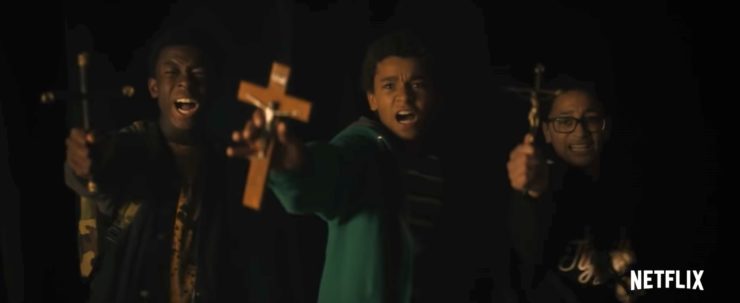When I was growing up as a young black/Puerto Rican teen in Queens, there weren’t an abundance of age-approriate horror films with BIPOC protagonists set in the city. So my inner child was beyond excited to hear that Netflix was releasing a PG-13 horror movie entitled Vampires vs. the Bronx that revolved around 3 BIPOC teens trying to defend their neighborhood from changing.
While I thoroughly enjoyed how authentic the Bronx felt and the movie’s main metaphor, all the things Vampires Vs. the Bronx got right weren’t enough to distract me from its issues. Although this movie brings a lot of good elements to the table, its inability to balance great themes with its story and characters resulted in an uneven horror flick.
[Spoilers for the film below]
Vampires vs. the Bronx begins with Zoe Saldana’s Becky selling her Bronx nail salon for a small fortune to Shea Wiggam’s Frank, a vampire familiar who runs Murnau realty. (The name should’ve been a red flag, as F.W. Murnau famously adapted Dracula into Nosferatu in the 1920s.) But before Becky can realize what’s going on, a pale vampire sneaks in and takes her out.
While it was sad—though expected—to see such a great actress go so early in the film, her death effectively introduces the threat while setting up the movie’s main metaphor: Gentrification is literally killing the Bronx. Director Osmany Rodriguez further hammers in this point by showing us dozens of boarded-up businesses across the neighborhood covered in Murnau realty signs. The local businesses are set to be replaced with stores like “Bone & Thread” and a “Small Batch Butter store” (which admittedly sounds delicious). But underneath these shiny new stores lie a group of monsters that want nothing more than to devour the neighborhood they invaded.
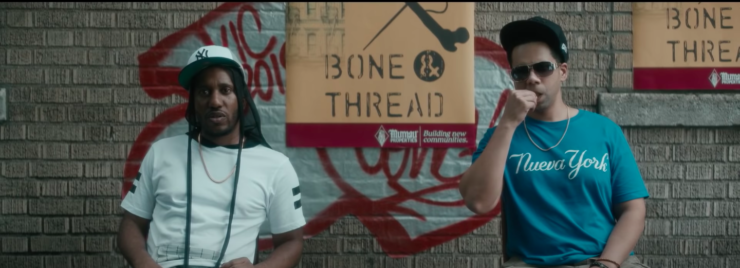
After the opening, Vampires vs. the Bronx focuses on building up the heroes and their vibrant neighborhood. Miguel, played by Jaden Michael, is a determined teen who posts flyers everywhere in an attempt to stop gentrification and save his local bodega. He eventually runs into his best friends, Bobby, played by Gerald W. Jones III, and Luis, who is played by Gregory Diaz IV. While Luis is your atypical nervous nerd, Bobby gets a much deeper backstory that sees him torn between joining a gang or sticking with his friends.
The fourth main character is the neighborhood itself. We get a series of shots showing off the music, homes, and businesses of the Bronx in loving detail. Spanish floats though the air freely and without subtitles. After lovingly establishing what our heroes are fighting for, it’s time for the vampiric action.
When Miguel posts a “Save the Bodega ” flyer on a Murnau realty sign, a vampire starts to stalk him. Once he convinces his friends the threat is real, they prepare by using Blade as a documentary to make a list of vampire weaknesses. It’s great to see them end the first act by hilariously referencing one of the first black superheroes (and vampire hunters) put onscreen. But after this point, the movie starts moving at a breakneck pace. In a extremely short time span, Miguel, Bobby, and Luis find their way into Murnau Realty, steal an important key, find a vampire nest, and get arrested for trespassing. In the midst of this whirlwind of events, Bobby leaves the trio.
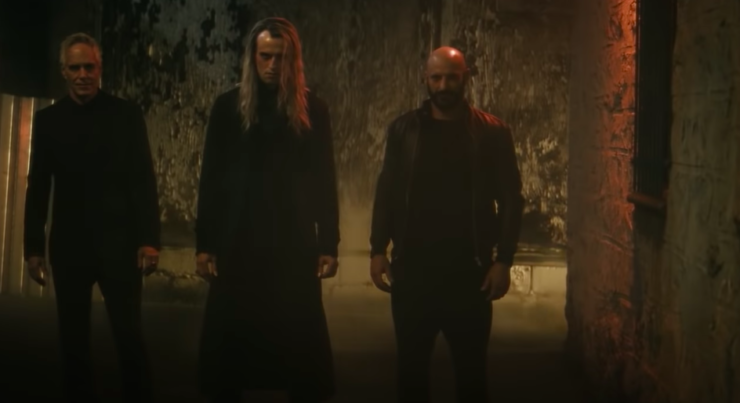
This rushed plotting isn’t helped by the rapid changes in tone. Shortly after Tony (the bodega owner and friend/confidante to the boys) is killed by vampires in an unsettling scene, we get a comedic sequence where Miguel and Luis steal holy water from Method Man’s angry Priest character, Father Jackson. Their funny quest is immediately followed by a harrowing scene where Bobby is asked to hold a gun and betray his friends for a gang. The jarring shifts made it very difficult to tell if the movie wanted to make us laugh or cry.
It’s only after the boys discover the vampires have taken Tony out that the film finds its way back into dark comedy territory. The main trio take their parents’ crucifixes off the walls, grab a legendary Sammy Sosa bat, and load up on adobo with garlic to defend themselves. Their decision to go into the final fight by using weapons representative of their neighborhood and culture is a tremendously funny decision that almost makes up for the mood whiplash.
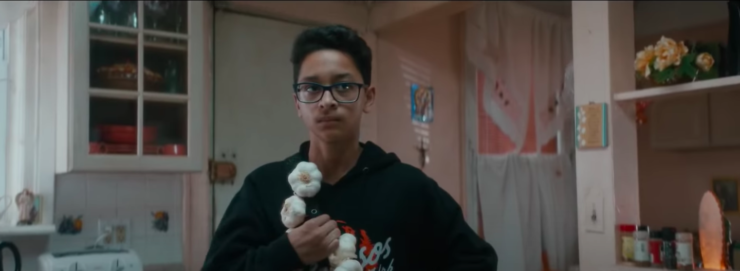
While the plot and tone were inconsistent, the film managed to explore the theme of gentrification effectively throughout. The vampires acquiring property in the Bronx are great stand-ins for the wealthy realtors who buy local businesses out and turn the properties into new stores meant to attract more outsiders. But there’s also a sobering reason why the Bronx is chosen: Both the vampires and city residents repeatedly say that nobody cares about what happens to people that live in the Bronx. In their experience, people could go missing daily and nothing would be done. While the vampires take advantage of that sentiment to feed on locals without repercussions, the Bronx residents try to keep hope alive while dealing with realistic issues.
Tony has to stock his bodega shelves with expensive and trendy foods he doesn’t understand in a desperate attempt to appeal to new customers. Saldana’s Becky was slowly being priced out of her neighborhood before she made a deal with vampires. And Bobby’s mother considers selling her apartment so she can get her family away from gang violence. For the residents of the Bronx, selling out isn’t just about the money—it’s about the opportunity to completely change your life. Unfortunately, giving away your property means that the people that remain are left with a neighborhood that looks nothing like the one they knew and loved.
Seeing a careful exploration of gentrification combined with horror elements in an NYC setting should’ve been enough to make the movie an instant classic. It’s unfortunate that the film couldn’t treat its characters with nearly as much subtlety.
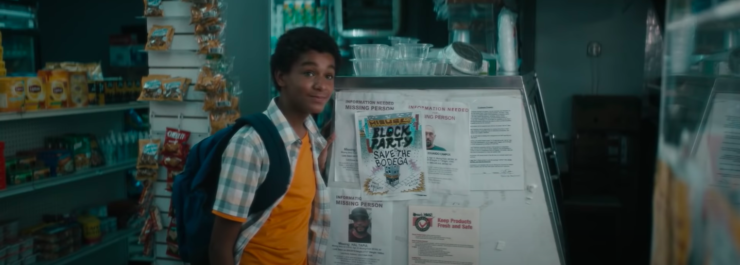
The main trio’s caretakers are all portrayed as stern, overbearing women who constantly embarrass their sons. All of the gangsters are cardboard cutouts that have no individuality. While they didn’t need complete character arcs, it would’ve been nice to see these characters have defining traits that made them more than tired stereotypes.
There are also a few interesting characters that are introduced only to be quickly shuffled out of the movie. The most egregious example of this is when Miguel’s crush Rita shows up to help destroy the vampire nest… only to leave to warn the neighborhood of the threat a few minutes later. Why introduce her if she’s not going to participate? It’s frustrating to see because the film knows how to handle character development. It’s legitimately compelling to watch Bobby tiptoe the line between slipping into a life of crime or letting his friends keep him on the right path. But since he’s not the main character, his powerful story is often sidelined. And while Miguel and Luis aren’t bad characters by any means, they don’t really grow or change.
The film’s heavy focus on its anti-gentrification message clearly took priority over the plot and characters. While this approach doesn’t make the film unwatchable, it definitely held the movie back from being a solid horror offering. If you’re curious about Vampires vs. the Bronx, its hour and a half runtime and availability on Netflix make for a quick and easy watch. Although it’s far from the best vampire tale you could sink your teeth into, this uneven horror story may convince you to invest in the Bronx… without changing a thing about the neighborhood.
Andrew Tejada is an NYC native so there’s a 90 percent chance this was written on the subway. When he’s not writing or consuming movies/tv, he’s pitching his Static Shock screenplay to anyone who’ll listen. More of Andrew’s projects and words can be found on Facebook at “Arete Writes Things.”










